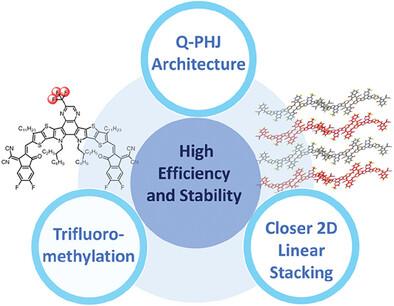Our official English website, www.x-mol.net, welcomes your feedback! (Note: you will need to create a separate account there.)
Trifluoromethylation Enables Compact 2D Linear Stacking and Improves the Efficiency and Stability of Q‐PHJ Organic Solar Cells
Small ( IF 13.0 ) Pub Date : 2024-07-01 , DOI: 10.1002/smll.202403821 Dongsheng Qiu 1 , Shilong Xiong 1 , Hanjian Lai 1 , Yunpeng Wang 1 , Heng Li 1 , Xue Lai 1, 2 , Yiwu Zhu 1 , Feng He 1, 3, 4
Small ( IF 13.0 ) Pub Date : 2024-07-01 , DOI: 10.1002/smll.202403821 Dongsheng Qiu 1 , Shilong Xiong 1 , Hanjian Lai 1 , Yunpeng Wang 1 , Heng Li 1 , Xue Lai 1, 2 , Yiwu Zhu 1 , Feng He 1, 3, 4
Affiliation

|
Compared to the bulk heterojunction (BHJ) devices, the quasiplanar heterojunction (Q‐PHJ) exhibits a more stable morphology and superior charge transfer performance. To achieve both high efficiency and long‐term stability, it is necessary to design new materials for Q‐PHJ devices. In this study, QxIC‐CF3 and QxIC‐CH3 are designed and synthesized for the first time. The trifluoromethylation of the central core exerts a modulatory effect on the molecular stacking pattern, leveraging the strong electrostatic potential and intermolecular interactions. Compared with QxIC‐CH3 , the single crystal structure reveals that QxIC‐CF3 exhibits a more compact 2D linear stacking behavior. These benefits, combined with the separated electron and hole transport channels in Q‐PHJ device, lead to increased charge mobility and reduced energy loss. The devices based on D18/QxIC‐CF3 exhibit an efficiency of 18.1%, which is the highest power conversion efficiency (PCE) for Q‐PHJ to date. Additionally, the thermodynamic stability of the active layer morphology enhances the lifespan of the aforementioned devices under illumination conditions. Specifically, the T80 is 420 h, which is nearly twice that of the renowned Y6‐based BHJ device (T80 = 220 h). By combining the advantages of the trifluoromethylation and Q‐PHJ device, efficient and stable organic solar cell devices can be constructed.
中文翻译:

三氟甲基化实现紧凑的二维线性堆叠并提高 Q-PHJ 有机太阳能电池的效率和稳定性
与体异质结(BHJ)器件相比,准平面异质结(Q-PHJ)表现出更稳定的形貌和优异的电荷转移性能。为了实现高效率和长期稳定性,有必要为Q-PHJ器件设计新材料。本研究首次设计并合成了QxIC-CF3和QxIC-CH3。中心核心的三氟甲基化利用强静电势和分子间相互作用对分子堆积模式发挥调节作用。与QxIC-CH3相比,单晶结构表明QxIC-CF3表现出更紧凑的2D线性堆积行为。这些优点与 Q-PHJ 器件中分离的电子和空穴传输通道相结合,可提高电荷迁移率并减少能量损失。基于D18/QxIC-CF3的器件表现出18.1%的效率,这是Q-PHJ迄今为止最高的功率转换效率(PCE)。此外,有源层形态的热力学稳定性提高了上述器件在光照条件下的寿命。具体来说,T80 为 420 小时,几乎是著名的基于 Y6 的 BHJ 设备(T80 = 220 小时)的两倍。通过结合三氟甲基化和Q-PHJ器件的优点,可以构建高效稳定的有机太阳能电池器件。
更新日期:2024-07-01
中文翻译:

三氟甲基化实现紧凑的二维线性堆叠并提高 Q-PHJ 有机太阳能电池的效率和稳定性
与体异质结(BHJ)器件相比,准平面异质结(Q-PHJ)表现出更稳定的形貌和优异的电荷转移性能。为了实现高效率和长期稳定性,有必要为Q-PHJ器件设计新材料。本研究首次设计并合成了QxIC-CF3和QxIC-CH3。中心核心的三氟甲基化利用强静电势和分子间相互作用对分子堆积模式发挥调节作用。与QxIC-CH3相比,单晶结构表明QxIC-CF3表现出更紧凑的2D线性堆积行为。这些优点与 Q-PHJ 器件中分离的电子和空穴传输通道相结合,可提高电荷迁移率并减少能量损失。基于D18/QxIC-CF3的器件表现出18.1%的效率,这是Q-PHJ迄今为止最高的功率转换效率(PCE)。此外,有源层形态的热力学稳定性提高了上述器件在光照条件下的寿命。具体来说,T80 为 420 小时,几乎是著名的基于 Y6 的 BHJ 设备(T80 = 220 小时)的两倍。通过结合三氟甲基化和Q-PHJ器件的优点,可以构建高效稳定的有机太阳能电池器件。











































 京公网安备 11010802027423号
京公网安备 11010802027423号